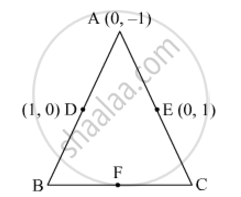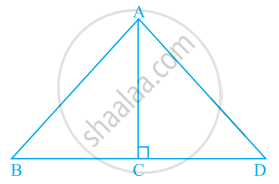Advertisements
Advertisements
Question
Show that the points are the vertices of an isosceles right triangle.
Solution
The given points are A (3, 0), B(6, 4) and C(-1, 3) Now,
`AB = sqrt((3-6)^2 +(0-4)^2 ) = sqrt((-3)^2 +(-4)^2)`
`= sqrt((9+16)) = sqrt(25) = 5`
`BC = sqrt((6+10)^2 +(4-3)^2 )= sqrt((7)^2+(1)^2)`
`=sqrt(49+1) = sqrt(50) = 5 sqrt(2)`
`AC = sqrt((3+1)^2 +(0-3)^2) = sqrt((4)^2 + (-3)^2)`
`= sqrt(16+9) = sqrt(25) =5`
`∵AB +AC and AB^2 +AC^2 = BC^2`
Therefore,A (3, 0), B(6, 4) and C(-1, 3) are die vertices of an isosceles right triangle
APPEARS IN
RELATED QUESTIONS
In Fig. 6, ABC is a triangle coordinates of whose vertex A are (0, −1). D and E respectively are the mid-points of the sides AB and AC and their coordinates are (1, 0) and (0, 1) respectively. If F is the mid-point of BC, find the areas of ∆ABC and ∆DEF.

Find the area of a triangle with vertices at the point given in the following:
(2, 7), (1, 1), (10, 8)
The vertices of ΔABC are (−2, 1), (5, 4) and (2, −3) respectively. Find the area of the triangle and the length of the altitude through A.
Two vertices of a triangle are (1, 2), (3, 5) and its centroid is at the origin. Find the coordinates of the third vertex.
prove that the points A (7, 10), B(-2, 5) and C(3, -4) are the vertices of an isosceles right triangle.
Show that ∆ ABC with vertices A (–2, 0), B (0, 2) and C (2, 0) is similar to ∆ DEF with vertices D (–4, 0), F (4, 0) and E (0, 4) ?
If the points (a1, b1), (a2, b2) and(a1 + a2, b1 + b2) are collinear, then ____________.
If `D((-1)/2, 5/2), E(7, 3)` and `F(7/2, 7/2)` are the midpoints of sides of ∆ABC, find the area of the ∆ABC.
Area of a right-angled triangle is 30 cm2. If its smallest side is 5 cm, then its hypotenuse is ______.
In the given figure, ratio of the area of triangle ABC to the area of triangle ACD is the same as the ratio of base BC of triangle ABC to the base CD of ΔACD.

